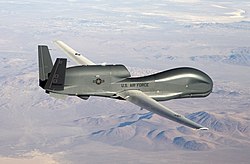Aborted military response
Following the incident, President Donald Trump tweeted that Iran had made a "big mistake". [31] The Federal Aviation Administration warned airlines of a "potential for miscalculation or misidentification" as numerous flights began to be diverted from the Tehran flight information region. [32] The United States also requested a June 24 closed-door United Nations Security Council meeting to address the regional tensions with Iran, according to diplomats. [33] Several hours later, The New York Times , citing "multiple senior administration officials involved in or briefed on the deliberations," reported that Trump had ordered a retaliatory military strike on several Iranian radar and missile sites, but then withdrew the order. Secretary of State Mike Pompeo, National Security Adviser John Bolton, and CIA Director Gina Haspel were reportedly in favor of a military response and objected to the reversal. [17] [34] [35] Vice President Mike Pence initially supported limited military strikes but also agreed with the president's decision to halt them. [36]
Trump later confirmed that he aborted an attack, tweeting that he was in "no hurry" to attack Iran and halted his order "10 minutes before the strike" because it was only then that he learned that Iranian casualties were estimated to be 150 killed, which he said was "not proportionate to shooting down an unmanned drone". [23] In an interview with NBC News, he expounded on his decision-making process, saying that though the strike package was "cocked and loaded", he had not given final approval to the operation and added that no warplanes had taken off before the reversal. He reiterated that he did not desire war with Iran and was open to unconditional talks with Iranian leadership, but affirmed that they "can't have nuclear weapons" and warned that in the event of a conflict there would be "obliteration like you've never seen before". [37]
A June 22 article in The Wall Street Journal , citing unidentified administration officials close to internal deliberations, reported that, privately, Trump bemoaned the cost of the downed drone – around $130 million (not including R&D) – but said that the loss would pale in comparison in the eyes of U.S. citizens to potential Iranian casualties. One source said the collateral damage estimate of 150 killed came from the White House, not the Pentagon, which two others said guessed lower. The WSJ report also stated that Chairman of the Joint Chiefs of Staff Joseph Dunford cautioned against a strike, significantly influencing Trump's decision. [36]
In leaked diplomatic documents, UK ambassador to Washington Kim Darroch questioned Trump's claim that he had aborted the missile strike because it would have caused 150 casualties, saying it "doesn't stand up". "It's more likely that he was never fully on board and that he was worried about how this apparent reversal of his 2016 campaign promises would look come 2020," Darroch posited. [38]
On June 23, Bolton warned Iran to not "mistake U.S. prudence and discretion for weakness" and that "no one has granted them a hunting license in the Middle East. Our military is rebuilt, new and ready to go." [39]
On June 27, a week after the incident, U.S. Air Force Chief of Staff David Goldfein confirmed that U.S. drone operations in the region were continuing unabated despite the shoot-down. The day prior, he also downplayed the regional tensions at the time, saying he did not see a "significant change" in the Iranian military's defensive posture or capabilities. [40]
Cyberattacks and sanctions
On June 22, it was reported that Trump had approved cyberattacks intended to disable IRGC computer systems used to control rocket and missile launches the day of the shoot-down. The cyber strikes were in development "for weeks if not months" and handled by U.S. Cyber Command in conjunction with U.S. Central Command. [41] It represented the first offensive show of force since Cyber Command was elevated to a full combatant command in May 2018. Also on June 22, the U.S. Department of Homeland Security issued a warning to U.S. industries that Iran was stepping up cyberattacks on critical industries — particularly oil, gas, and other energy sectors — and government agencies, and have the potential to disrupt or destroy systems. [42]
On June 24, Trump announced new targeted sanctions in Executive Order 13876 against Iranian and Revolutionary Guard Corps leadership, including Supreme Leader Ali Khamenei and his office. IRGC targets included Naval commander Alireza Tangsiri, Aerospace commander Amir Ali Hajizadeh and Ground commander Mohammad Pakpour. The sanctions also targeted the commanders of the IRGC Navy's five districts: Abbas Gholamshahi, Ramezan Zirahi, Yadollah Badin, Mansour Ravankar, and Ali Ozma'i. [43] [44] The sanctions largely froze any assets under U.S. jurisdiction, blocked the targeted leaders from dollar-denominated transactions, and barred international banks from moving money on their behalf. U.S. Treasury Secretary Steven Mnuchin said the sanctions would block "literally billions" in assets and that Iranian Foreign Minister Javad Zarif would also be sanctioned within the week. [45] Zarif was later sanctioned on July 31. [46]
Also on June 24, Iranian Information and Communications Technology Minister Mohammad-Javad Azari Jahromi said the cyberattacks were firewalled, commenting "They try hard, but they have yet to carry out a successful attack." [47] This followed a report in The New York Times, citing current and former officials, saying the Trump administration was urging U.S. military and intelligence officers to develop new methods for unconventional clandestine operations against Iran, to avoid using conventional military options. [48]





